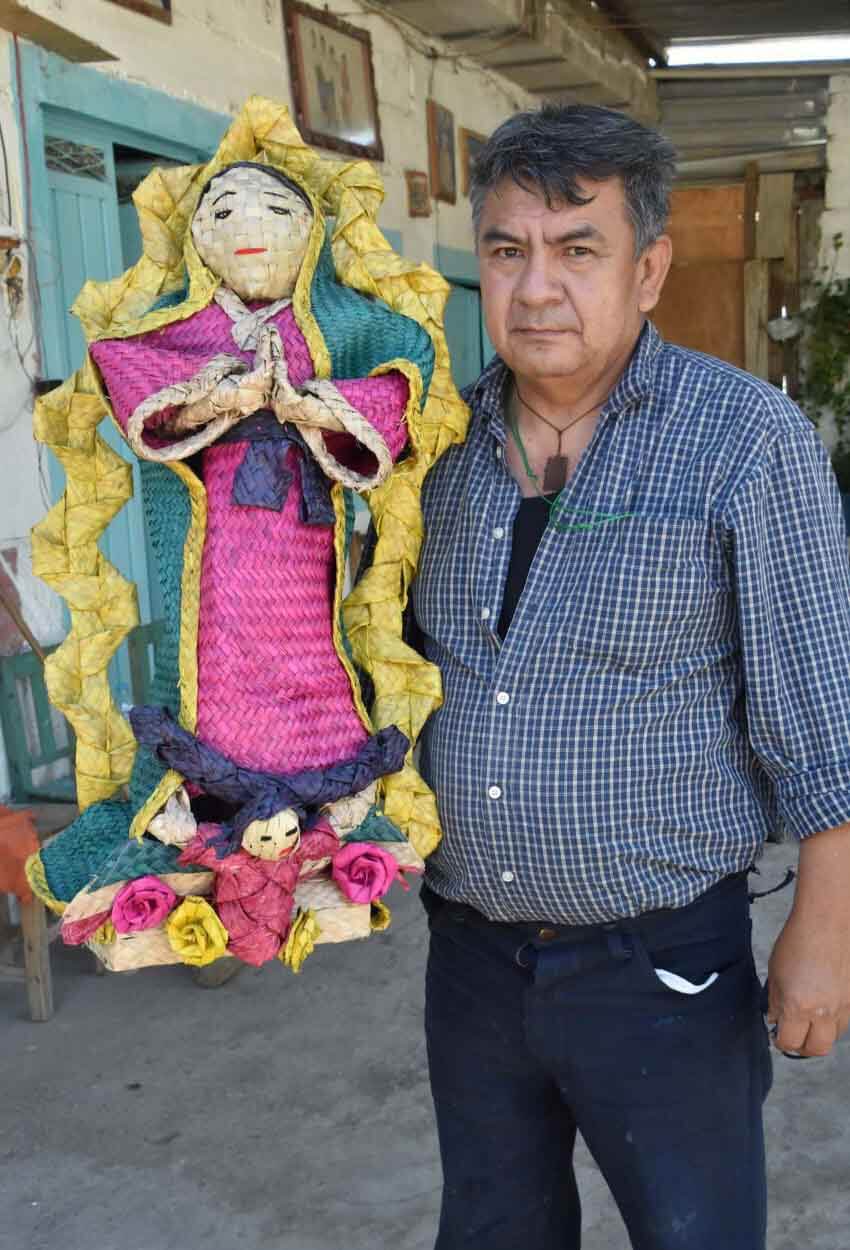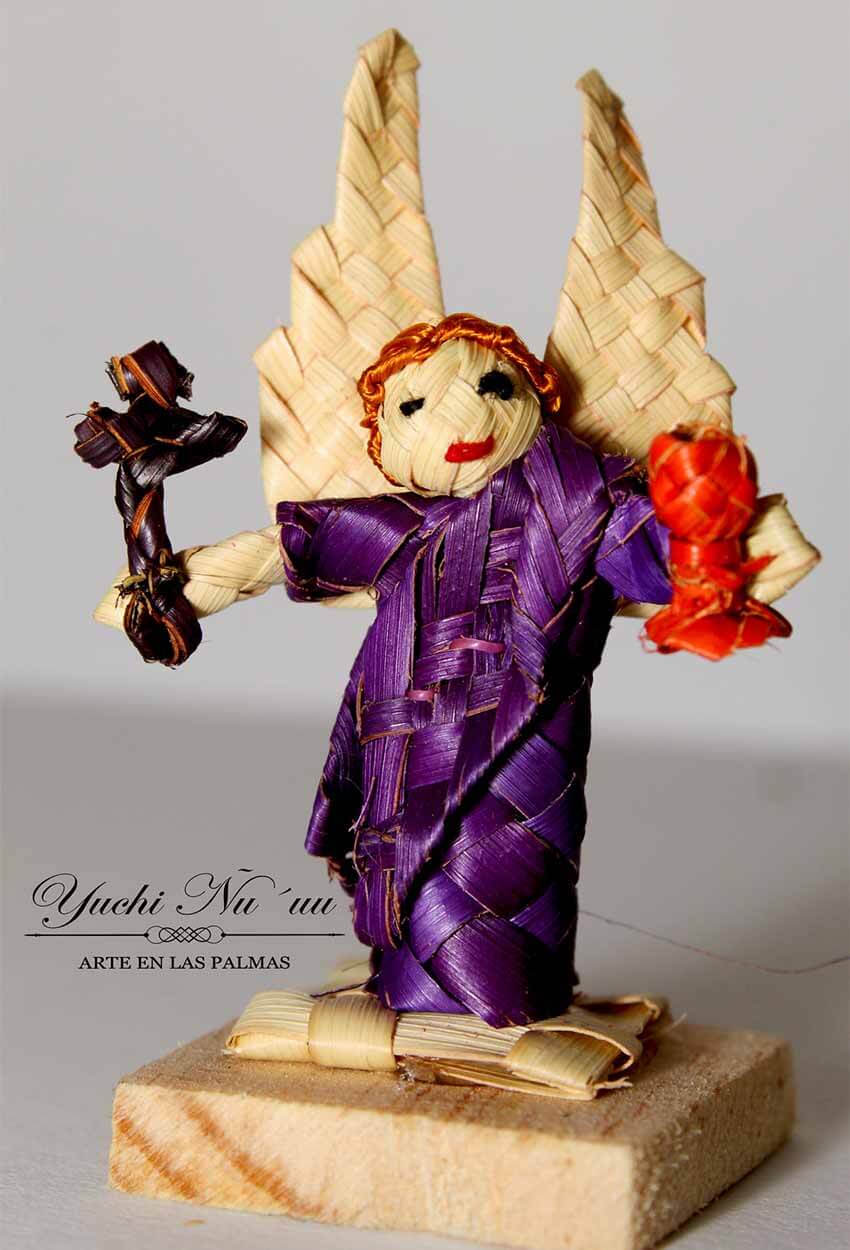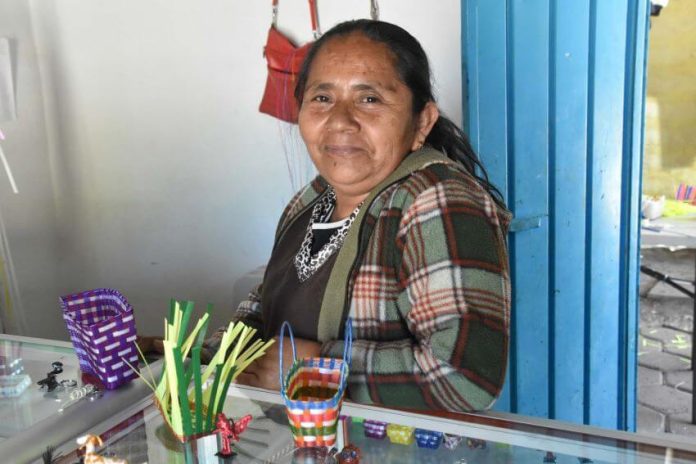“People in this pueblo have magic hands,” said Jesús Iván Ríos Piñeda, who served as my guide during a day in Santa María Chigmecatitlán, Puebla, which is located two hours south of Puebla city. People use their magic hands here to make intricate figures and other items from palm fronds or from plastic strips called rafia.
The Mixtecas, indigenous people who occupied — and still do — parts of Puebla, Oaxaca and Guerrero, have used palm fronds to weave mats, baskets and other items for hundreds of years, since well before the Spanish arrived. In 1642, this knowledge was brought to what is now Santa María Chigmecatitlán.
According to local oral history, the pueblo was founded when a group of Mixteca from Oaxaca, after wandering for 30 years, stopped at a mesquite tree and hung a canvas depicting the Virgin of Guadalupe on one of its branches. After that, they saw a coyote walking among some vines nearby.
The group decided to name the pueblo after the Virgin and the coyote: Chigmecatitlán is Mixteca for “dog among the vines.”
The pueblo’s founding is celebrated every December 8 with the canvas being hung again on a mesquite tree. Ríos said coyotes still live in the area but to date, none have appeared during the celebration.

Although the Mixtecas had woven utilitarian items for centuries, weaving palm fronds into figures probably didn’t start until the early 20th century. Artisans in Santa María Chigmecatitlán are most famous for their miniature figures — as small as one inch high — that are exquisitely detailed.
These miniatures didn’t appear until the mid-1960s, when the Gallardo Osorio family started to make them. Other families began making miniatures soon afterward.
The fronds used to make the figures are typically found near the pueblo and cut in March or April and again at the end of the year, when there is little or no rain. Once dried and cleaned, they’re ready to be used.
“Only people in this pueblo make miniature figures,” said María Verónica Peralta Ordones as she sat at her worktable. “I learned from my grandmother, first making chiquihuites (baskets) and purses. Before, people made chiquihuites, but now make mostly figures.”
If someone wanted to learn how to make the figures, Peralta said, they’d start with weaving a very small mat she called a tejida, “It would take probably 15 days, working constantly,” she said. “And one must have agile fingers.”
Before making a figure, Peralta first places the palm fronds in a damp cloth for 30 minutes to moisten them. This makes them flexible. Using a needle, she then deftly slices them into very thin strips. Then her fingers take over.
As I watched in amazement, she somehow looped, twisted and wove those strips first into the body of an angel, then into its base and head. After connecting the head, she added its eyes, mouth and hair using a needle and colored thread. Finally, she wove and attached a belt, trumpet and wings.
To say her fingers moved expertly would be a gross understatement. They moved, as Ríos had said they would, magically.
“To do this work,” Peralta said, “one needs much patience, caring and love.”
She completed the angel, just over one inch in height, in less than an hour, but other figures take considerably longer. “A Catrina figure [the iconic Day of the Dead skeleton figure] of 12 centimeters takes about nine hours to make,” she said.
A nativity scene she made with a couple of dozen miniature figures required 20 days of work. “Challenges do not frighten me,” she said. That piece took second place at a Fonart (the federal handcrafts agency) regional competition in 2011.
A short walk from Peralta’s workshop is Mario Cabrera Ibañez’s store, Yuchi Ñuuu. “The name is Mixteca for ‘bits of palm,’” he said.

In addition to dozens of miniature figures on display, there were several large pieces in the store. One, of the Virgin of Guadalupe, was close to three feet tall.
“That took me 15 days to make, working eight hours a day,” said Cabrera. “I prefer to make miniatures, but it is all the same.”
In addition to working in palm, Cabrera and his family make items from rafia, thin plastic strips that imitate the fibers of natural raffia palm leaves. “My children work in rafia, which is faster,” he said. “I work in palm, which is more difficult. I sometimes work in rafia, but I prefer palm because of tradition.”
Just a short drive away, Sirenia Bardovino Pineda was weaving some chiquihuites out of rafia in her store. “I prefer rafia because it comes ready,” she said. “I do not need to clean or paint it.”
She said it takes about an hour to make a small chiquihuite.
“To learn how to make one takes two to seven days, depending on the person.” One of the most popular items made from rafia is the sonaja (rattle), of which there are at least 200 types. Bardovino said that, in addition to her store, she sometimes sells at fairs in other pueblos and cities. But, she mentioned, people often want to pay less. “There is a lot of bargaining,” she said.
Peralta estimates that there are 50 families — most of them related — in the pueblo who make the palm figures. Each family has its own unique style. But, sadly, it may be a dying art.
“I do not think young people will continue making these because it is difficult to survive economically,” she said. “Few young people make them, but I hope my granddaughters continue making them. My daughter also knows how to make them. More young people are musicians or join the military. They leave. Many know how to weave, but they prefer to do other things.”
Like everywhere, the pandemic has impacted the Santa Maria Chigmecatitlán, with fewer people coming to buy figures. But it did have one positive effect. “More young people stayed and learned how to work in palm,” said Peralta.
There were no tourists in town the day I was there and no customers in the stores. Some of the artisans said they sell their wares at fairs in different cities, but that requires a lot of traveling and expense.
“Many people have a second job,” said Ríos. In addition to making the figures, he works in construction. “I have to in order to survive.”
Yet, despite the difficulties, all the artisans I spoke with want to continue this work.

“I have a special affection for my work because I learned from my grandparents,” said Peralta. “My work helps me remember my grandparents.”
“I love my pueblo,” she added. “I love its people, its history. I love my work. It is a remembrance of my grandparents and a connection with my family. I want to continue working in palm. Mother Nature gave us this culture.”
• Items in Mario Cabrera Ibañez’s store Yuchi Ñuuu can be seen on his Facebook page.
•María Verónica Peralta Ordones Peralta may be contacted at 224-104-9208
• Sirenia Bardovino Pineda can be reached at 224-115-5982.
Joseph Sorrentino, a writer, photographer and author of the book San Gregorio Atlapulco: Cosmvisiones and of Stinky Island Tales: Some Stories from an Italian-American Childhood, is a regular contributor to Mexico News Daily. More examples of his photographs and links to other articles may be found at www.sorrentinophotography.com He currently lives in Chipilo, Puebla.
